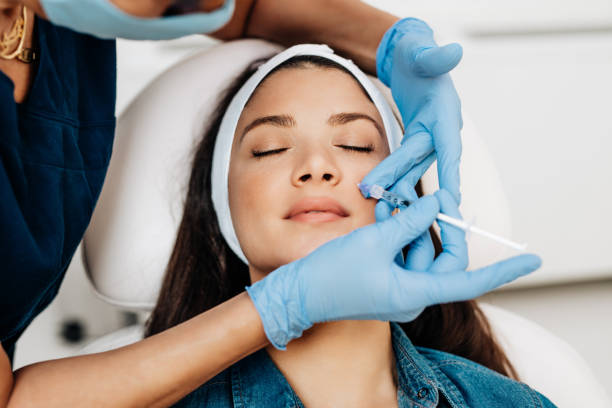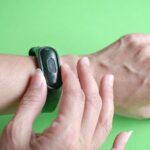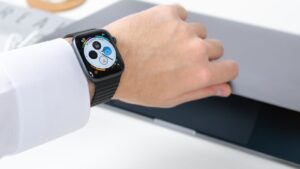
If you’re looking for alternatives to microdermabrasion, there are several options that can help improve your skin’s texture and appearance without the use of harsh exfoliants.
- Chemical peels: This procedure involves the application of a chemical solution to the skin, which causes the top layers of dead skin to peel off. Chemical peels can help reduce the appearance of wrinkles, acne scars, and age spots.
- Laser resurfacing: This technique uses a laser beam to remove the outer layer of skin cells, stimulating the growth of new skin cells in the process. Laser resurfacing can help reduce fine lines, acne scars, and other skin imperfections.
- Dermaplaning: This procedure involves the use of a surgical scalpel to remove the top layer of dead skin cells and vellus hair (peach fuzz) from the face. Dermaplaning can help improve the skin’s texture and make it look smoother and brighter.
- Microcurrent therapy: This technique involves the use of low-level electrical currents to stimulate the muscles and cells in the face, helping to increase blood flow and promote collagen production. Microcurrent therapy can help lift and tighten sagging skin and reduce the appearance of wrinkles.
Pro tip: Consult with a dermatologist or skincare professional to determine which alternative treatment is best for your skin type and specific concerns.
Chemical Peels As An Alternative To Microdermabrasion
Microdermabrasion is a commonly used skin treatment that uses exfoliation to reduce the appearance of wrinkles, sunspots, and other skin imperfections, but there are other alternatives available to achieve the same results. One such alternative is the use of Chemical Peels. Chemical Peels provide a more targeted and intense approach to exfoliation and can be beneficial for those seeking more visible results. Let’s explore the other benefits and drawbacks of Chemical Peels as an alternative to microdermabrasion.
What Are Chemical Peels and How Do They Work?
Chemical peels are a cosmetic treatment that uses various types of acid solutions to remove damaged or dull layers of skin from the face, neck, or hands. Chemical peels are an effective alternative to microdermabrasion. The acid solutions in chemical peels react with the top layers of the skin, breaking them down and causing them to peel off. This process stimulates the production of new skin cells and collagen, resulting in a brighter, smoother, and more youthful-looking complexion.
Chemical peels can be classified into three types:
- Superficial peels: They use mild acids to treat the outermost layers of the skin, resulting in radiant and refreshed skin.
- Medium peels: They use stronger acids to penetrate deeper into the skin, targeting fine lines, wrinkles, and acne scars.
- Deep peels: They use the strongest acids to remove multiple layers of skin, targeting severe wrinkles and sun damage, but require longer recovery time.
Chemical peels are an adaptable treatment that can be customized to address various skin concerns, but they should always be performed by a trained professional.
Benefits Of Chemical Peels Over Microdermabrasion
Chemical peels serve as a better alternative to microdermabrasion because of the following benefits:
- Chemical peels offer a deeper exfoliation of your skin compared to microdermabrasion which primarily deals with the top layers of the skin.
- Chemical peels work on acne scars, uneven skin tones, and fine lines, while microdermabrasion cannot effectively treat these issues.
- Chemical peels can be customized to suit the specific needs of your skin, whereas, with microdermabrasion, it is more challenging to personalize treatments according to unique skin types.
- Chemical peels are less invasive than microdermabrasion and require less time to heal.
- Chemical peels offer the added advantage of increasing collagen and elastin production, leading to firmer, plumper skin.
Overall, chemical peels provide a more thorough and tailored skin rejuvenation experience, making them a preferred choice over microdermabrasion for long-lasting and visible results.
Different Types Of Chemical Peels To Consider
Chemical peels are an effective alternative to microdermabrasion for improving the texture and appearance of your skin. There are three main types of chemical peels to consider, each with varying levels of intensity and results.
- Superficial Peels: These are gentle peels that only remove the top layer of skin, consisting of dead skin cells. They are ideal for minor skin issues and do not require any downtime for recovery.
- Medium Peels: This type of peel penetrates deeper into the skin to target dark spots, fine lines, and acne scars. They may require a few days of downtime for recovery and may result in slight peeling or redness.
- Deep Peels: These are the most intense type of chemical peel and penetrate several layers of skin to target severe acne scars, deep wrinkles, and hyperpigmentation. They require more recovery time, up to two weeks, and may result in significant peeling, redness, and discomfort.
It’s important to consult with a skincare professional to determine which type of chemical peel is best suited for your skin concerns and skin type.

Micro-needling As An Alternative To Microdermabrasion
Micro-needling, otherwise known as collagen induction therapy, is a popular alternative to microdermabrasion. It is a minimally invasive, cost-effective procedure that utilizes micro-needles to create tiny punctures in the skin in order to stimulate collagen production and skin rejuvenation. This section will discuss the advantages and disadvantages of micro-needling as an alternative to microdermabrasion.
What Is Micro-Needling and How Does It Work?
Micro-needling is a minimally invasive cosmetic procedure that uses a device studded with tiny needles to create controlled micro-injuries to the skin, stimulating the body’s natural healing process and collagen production. During a micro-needling session, the needles penetrate the top layers of the skin, opening micro-channels that allow topical serums, creams, and other products to penetrate deeper into the skin.
This procedure can help reduce the appearance of acne scars, fine lines, and wrinkles, as well as improve skin texture, tone, and overall appearance. As a comparison, micro-needling is often considered to be a more targeted and effective alternative to microdermabrasion, as it can address deeper skin concerns and produce longer-lasting results.
Benefits Of Micro-Needling Over Microdermabrasion
Micro-needling is a more effective and versatile alternative to microdermabrasion for several reasons. Here are the benefits of micro-needling over microdermabrasion:
- Stimulates Collagen: Micro-needling stimulates collagen production leading to better skin texture and reduces fine lines and wrinkles. In contrast, microdermabrasion is only a surface-level treatment.
- Treatment customization: Micro-needling allows for customized treatment depth depending on skin type and concerns, while microdermabrasion only works on the surface of the skin.
- Treats acne and scarring: Micro-needling can be used to treat active acne, acne scars and other skin imperfections, while microdermabrasion cannot penetrate the skin deeply.
- Minimal Downtime: Micro-needling has less downtime as compared to microdermabrasion.
- Cost effective: Micro-needling can offer results in fewer treatments than microdermabrasion.
Overall, micro-needling is a more versatile and effective alternative to microdermabrasion for a variety of skincare concerns.
Pro Tip: Consult a dermatologist for treatment recommendations based on your skin type and concerns.
Different Types Of Micro-Needling To Consider
Micro-needling, also known as collagen induction therapy, is an effective alternative to microdermabrasion that involves puncturing the skin with tiny, sterile needles to promote skin rejuvenation. Here are three different types of micro-needling to consider:
- Cosmetic micro-needling: This method uses a small handheld device with fine needles to create microchannels in the skin. It is used to treat fine lines, wrinkles, and acne scars.
- Medical micro-needling: This procedure involves using a medical-grade roller or pen with longer needles to penetrate the skin deeper. It is commonly used to treat scars, stretch marks, and deep wrinkles.
- Automated micro-needling: This type of micro-needling uses a pen-like device with electric needles that rapidly create microchannels in the skin. It is a more controlled and precise method and is used to treat a variety of skin concerns.
Pro Tip: While micro-needling is generally considered safe, it is important to do your research and choose a qualified professional to perform the procedure.
Laser Skin Resurfacing As An Alternative To Microdermabrasion
Laser skin resurfacing is a more intensive treatment than microdermabrasion, with more significant results. It is a non-invasive procedure that works at a deeper level of the skin, targeting the collagen and elastin that support the skin’s structure and help produce a firmer, smoother, and more youthful looking appearance.
Laser skin resurfacing can provide a more dramatic reduction in wrinkles and fine lines, and can also be used to treat skin discoloration, sun damage, and acne scars. In this article, we will discuss the advantages and disadvantages of laser skin resurfacing as an alternative to microdermabrasion.
What Is Laser Skin Resurfacing And How Does It Work?
Laser skin resurfacing is a non-invasive cosmetic procedure that uses laser technology to improve the appearance of skin texture, reduce fine lines, remove scars, and treat hyperpigmentation. It works by using a focused laser beam to target the outermost layers of the skin, removing damaged or dead skin cells and stimulating collagen production. Laser skin resurfacing is a great alternative to microdermabrasion for people who want a more dramatic improvement in their skin’s appearance. Unlike microdermabrasion, which uses a handheld device to buff away surface skin, laser skin resurfacing can target deeper layers of the skin, leading to more significant results.
However, laser skin resurfacing is not suitable for everyone. It can be more painful than microdermabrasion and may require a longer recovery time. It’s also more expensive, making it less accessible for people on a budget. If you’re interested in alternatives to microdermabrasion, talk to your dermatologist about laser skin resurfacing, or other treatments that may be better suited to your skin’s needs. Pro Tip: Always weigh the pros and cons of different skin treatments before making a decision.
Benefits Of Laser Skin Resurfacing Over Microdermabrasion
Laser skin resurfacing offers several benefits over microdermabrasion as an alternative for skin rejuvenation. Some of the benefits include:
- More precise treatment: Laser skin resurfacing uses targeted beams of light to penetrate deeper layers of the skin, resulting in more precise treatment than microdermabrasion.
- Faster healing time: Laser skin resurfacing typically involves a shorter downtime and faster healing than microdermabrasion, which can take several days to recover from.
- Improved results: Laser skin resurfacing can address more severe skin issues, such as deep wrinkles, scars, and hyperpigmentation, delivering superior results compared to microdermabrasion.
However, it’s important to note that laser skin resurfacing is a more invasive procedure and may come with potential risks and side effects that should be discussed with a qualified dermatologist. Pro tip: Always consult a dermatologist to determine which procedure is most appropriate for your skin concerns.

Different Types Of Laser Skin Resurfacing To Consider
Laser skin resurfacing is an effective alternative to microdermabrasion that can improve the texture, tone, and overall appearance of your skin. Here are some of the different types of laser skin resurfacing to consider:
- Ablative Lasers: These lasers remove the outer layer of skin to reveal smoother and more youthful skin underneath. The two primary types of ablative lasers are:
- CO2 Lasers – Ideal for treating deep facial wrinkles, sun damage and acne scars.
- Erbium Lasers – Recommended for treating fine lines, shallow wrinkles, sun damage, and age spots.
- Non-ablative Lasers: These lasers penetrate the skin without removing any layers, stimulate collagen production, and tighten the skin. These lasers require multiple treatments to achieve optimal results.
- Fractional Lasers: These lasers deliver thousands of microscopic laser beams to the skin leaving the surrounding tissue intact. These lasers help with skin rejuvenation and can also treat skin pigmentation issues.
Consult with a medical professional to determine which type of laser skin resurfacing is best for your individual needs.
Facial Scrubs and Exfoliating Products As An Alternative To Microdermabrasion
Microdermabrasion is a popular facial treatment used to reduce the signs of aging on the skin. However, for those who may not have access to a professional microdermabrasion treatment, there are other alternatives available. Facial scrubs and exfoliating products are a great way to provide some of the same benefits as microdermabrasion without the high cost or time commitment. In this article, we will look into facial scrubs and exfoliating products as an alternative to microdermabrasion.
What Are Facial Scrubs And How Do They Work?
Facial scrubs are exfoliating products that work to remove dead skin cells from the surface of the skin. These products contain granules or particles that mechanically scrub away at the skin, revealing a smoother, brighter complexion. High-quality facial scrubs work by using a combination of physical and chemical exfoliants. The physical exfoliants, such as sugar or ground almonds, work to manually remove the top layer of dead skin cells. The chemical exfoliants, such as alpha and beta hydroxy acids, penetrate deeper into the skin to dissolve the glue-like substance that holds dead skin cells together.
If you’re looking for an alternative to microdermabrasion, facial scrubs and exfoliating products can be a great option. These products are affordable, easy to use at home, and can be customized to your skin type and preferences. However, it’s important to choose a gentle, non-abrasive formula to avoid causing any skin damage. Remember to limit your use to 2-3 times a week and always follow up with a hydrating moisturizer.
Pro Tip: Always Patch test new products on a small area of skin before applying it to your entire face to minimize the chances of irritation or adverse reaction.
Benefits Of Facial Scrubs Over Microdermabrasion
Facial scrubs and exfoliating products are a great alternative to microdermabrasion, with benefits that make them more accessible and cost-effective for regular use. Facial scrubs work by removing dead skin cells through gentle friction, revealing brighter and smoother skin. They are easy to use, require no special equipment or training, and can be done in the comfort of your own home. Exfoliating products come in various forms, including chemical peels, enzyme masks, and alpha hydroxy acids, and can be tailored to your specific skin type and concerns.
Microdermabrasion, on the other hand, involves using a machine to exfoliate and resurface the skin, which can be painful and may cause redness or irritation. It also requires a licensed esthetician to perform and can be expensive for regular treatments. In summary, facial scrubs and exfoliating products provide a gentler and more accessible alternative to microdermabrasion, with similar benefits for skin renewal and rejuvenation.
Different Types Of Facial Scrubs And Exfoliants To Consider.
Facial scrubs and exfoliating products are a great alternative to microdermabrasion, but with so many types available, how do you choose the right one for your skin? Here are the different types of facial scrubs and exfoliants to consider.
- Physical Scrubs: These scrubs contain small particles, such as sugar or salt, that physically exfoliate the skin. They are best for oily or combination skin types.
- Chemical Exfoliants: These exfoliants contain alpha-hydroxy acids (AHAs) or beta-hydroxy acids (BHAs), which dissolve dead skin cells to reveal smoother, brighter skin. They are ideal for dry or sensitive skin types.
- Enzyme Exfoliants: These exfoliants use natural enzymes, such as papaya or pineapple, to gently remove dead skin cells. They are suitable for all skin types, especially sensitive skin.
- Microbead Scrubs: These scrubs use tiny plastic beads to exfoliate the skin. While effective, they can harm the environment so it’s best to avoid them.
By choosing the right exfoliating product for your skin type, you can achieve smooth and radiant skin without the need for microdermabrasion.










